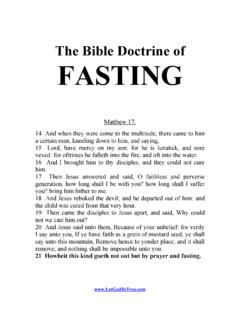Transcription of Intermittent Fasting (Time-Restricted Eating)
1 Intermittent Fasting ( time - restricted eating ). Fed vs. Fasted Your body is designed to smoothly transition between two different and opposing states: Fed', and Fasted'. In the fed state, insulin is elevated, and this signals your body to store excess calories in your fat cells. In the presence of insulin, the burning of fat is halted, while the body burns glucose (from your last meal) instead. In the fasted state, insulin is low (while glucagon and growth hormone, opposing hormones to insulin, are elevated). The body starts mobilizing stored body fat from your fat cells and burning this fat for energy (instead of glucose). The practical importance of all this? You can only burn stored body fat while in the fasted state, and you can only store more body fat while in the fed state.
2 Insulin Resistance Unfortunately, over time we seem to be spending less and less of our time in the fasted state and more and more time in the fed state. As a result, our bodies and our cells spend less and less time mobilizing and burning stored body fat for energy, and the glucose-burning pathways are overused. Eventually, insulin is high all the time and the body avoids burning stored body fat, relying mostly on glucose. Over time , this chronic exposure to so much insulin also leads to insulin resistance' where the body secretes even more insulin in response to the fed state. Chronic insulin resistance is the cause of Metabolic Syndrome': obesity, abdominal fat storage, high triglycerides, low HDL or good cholesterol, and elevated glucose with eventual type 2 diabetes (1 in 12 humans on earth currently have full blown type 2 diabetes, while 35% of adults and 50% of older adults have Metabolic Syndrome, or pre-diabetes).
3 Someone with insulin resistance is burning predominately glucose on the cellular level, and they rarely ever get the opportunity to burn any body fat. When these people run out of glucose from their last meal, instead of easily transitioning over to the fasted state to burn fat, they become hungry for more glucose (from carbohydrates) as their bodies and cells have decreased capacity for mobilizing and burning fat for energy. Let's put it this way. Why would a highly obese person EVER be hungry? They have enough fat stores to last a very long time . The world record for Fasting went to a 456 pound man who fasted for 382 days, consuming only water and vitamins and losing 276 pounds with no ill effects. But the average overweight person is used to being in the fed state, has very little practice in the fasted state, and is continually burning glucose rather than fat at the cellular level.
4 They have insulin resistance, which is both caused by and also leads to chronically high insulin levels, which promotes fat storage and suppresses fat mobilization from the adipocytes (fat cells). They even have changes in the mitochondria, or tiny energy factories inside the cells. The mitochondria can burn either glucose (sugar) or fat for fuel, and over time they will have a preference for one over the other; sugar burners have increased the pathways in the mitochondria that burn glucose and decreased, or down-regulated, the underused pathway for burning fat. So what happens to the overweight sugar burner who stops eating for a few hours? As they run out of glucose from their last meal, instead of seamlessly transitioning to the fasted state and mobilizing and burning stored body fat, they become HUNGRY for MORE GLUCOSE, from carbohydrates!
5 They will spend most of the day trapped in a cycle of eating every few hours, spiking glucose, and then becoming hungry when blood sugar drops. A good analogy is that of a tanker truck on the freeway filled with oil. If the tanker truck runs out of gas it stops moving, despite the fact that it has 10,000 gallons of potential fuel on board. Why? Because it prefers to run on refined gas and is incapable of burning oil for fuel. Fat Adaptation Humans have the ability to become fat- adapted' and improve their ability to fuel themselves with stored body fat instead of glucose. However, this takes time and practice, and your body has to do a number of things to slowly up-regulate (or increase) your fat-burning pathways. This includes improving insulin sensitivity to lower insulin and promote fat mobilization into free fatty acids from the adipocytes (fat cells) as well as up- regulating the fat-burning pathways at the cellular level (in the mitochondria).
6 There are several ways to improve fat adaptation' or the ability to successfully burn stored body fat for energy, and these include the following: Low carbohydrate diets. eating a LCHF (Low Carb High Fat) diet improves the body's ability to utilize fat for energy rather than glucose, as there is more fat and less glucose available at all times, even in the fed state. Exercise. High-intensity exercise depletes glucose and glycogen rapidly, forcing the body to switch over and utilize more fat for fuel. Exercise also improves insulin sensitivity. Caloric restriction. eating fewer calories also equals less glucose available for fuel, so the body is more frequently forced to rely on stored body fat for fuel. You will always naturally eat the lowest calories when you are maximizing nutrient density by eating whole, natural, unprocessed, real foods found in nature (avoid processed foods completely).
7 Intermittent Fasting , and spending more time in the fasted state, which gives the body more practice' at burning fat. Metabolic Exercise The purpose of this is to highlight Intermittent Fasting as a strategy for exercising and strengthening the body's ability to exist in the fasted state, burning fat instead of continually burning sugar (glucose) from the fed state. Just like anything else, this ability can be strengthened over time with practice. But this ability also atrophies or shrinks over time with lack of use, just like your muscles atrophy when you break your arm and have to wear a cast for weeks. Spending time in the fasted state is actually a form of exercise a METABOLIC WORKOUT. In fact, there are a lot of parallels between exercise and Fasting .
8 Exercise does all of the following great things: Decreases blood glucose. Decreases insulin level. Increases insulin sensitivity. Increases lipolysis and free fatty acid mobilization. Increases cellular fat oxidation. Increases glucagon (the opposite of insulin). Increases growth hormone (the opposite of insulin). BUT did you know you can also accomplish all of the above by doing ABSOLUTELY NOTHING? The secret is * Fasting *. Extending the amount of time that you spend during your day in the FASTED state (as opposed to the FED state). accomplishes all of these, very similar to exercise. Extending your time in the fasted state is actually a form of metabolic 'exercise', in which you train your body to rapidly and efficiently mobilize free fatty acids from your adipose stores (fat tissue), something you absolutely can get better and better at with the metabolic 'practice' of Fasting .
9 Just as overweight and out of shape people struggle to jog or lift weights or participate in other forms of physical exercise, they are also generally out of practice when it comes to rapidly and efficiently mobilizing and burning stored free fatty acids for fuel. Intermittent Fasting and spending more of your day in the 'fasted' state (and less time in the 'fed' state) is a great form of metabolic 'exercise' which has many health benefits, including fat loss! Less Feeding, More Fasting One of the best ways to achieve effortless and long-lasting fat loss? Train yourself to eat two meals a day (and eliminate snacking). The easiest and best way to accomplish this? Leverage your natural overnight fast by skipping breakfast (drinking coffee makes this easier and more enjoyable, plus coffee has numerous health benefits).
10 No breakfast, lighter lunch, and larger dinner also maximizes the body's natural shifts between sympathetic ( fight or flight ) and parasympathetic ( rest and digest ) nervous system tone, with higher alertness and activation from sympathetic tone during the day while under- eating , and higher parasympathetic resting tone in the evening during the fed state. Typically, the fed state starts when you begin eating and for the next three to five hours your body digests and absorbs the food you just ate. Insulin rises significantly, completely shutting off fat-burning and also triggering excess calories to be stored as fat. After the first few hours mentioned above, your body goes into what is known as the post absorptive state, during which the components of the last meal are still in the circulation.









